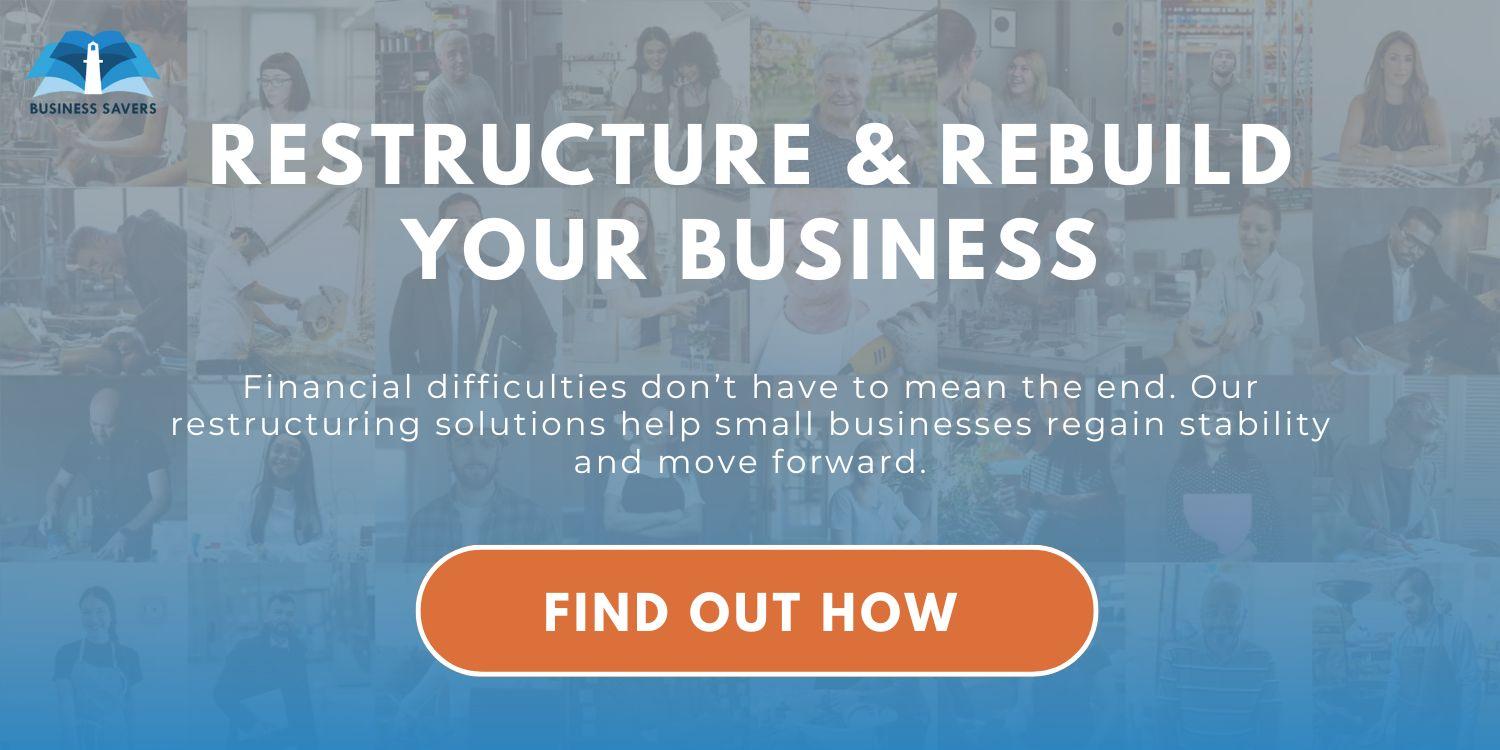A Plain English Guide to Small Business Debt Restructuring Solutions

Small business debt restructuring helps struggling companies reduce debt while staying in control of daily operations. The Small Business Restructuring Process (SBRP) has grown into Australia’s most popular insolvency solution since it was introduced to help businesses navigate the economic effects of COVID-19.
SBRP gives business owners a government-approved alternative to liquidation. It’s also different from many other insolvency options, since it allows directors to continue trading and maintain control while fixing internal problems.
We’ve put together this guide to give you the facts and help you decide whether small business debt restructuring is the right solution for you. You’ll learn how it works, who can apply, and what to expect along the way to financial recovery.
What is Small Business Debt Restructuring?
In basic terms, the small business restructuring process helps financially troubled small businesses reorganise their debts and survive.
A simple definition
Small business debt restructuring lets struggling companies change their operations to repay outstanding debts while staying open. That means that, unlike with traditional insolvency options, you can keep running day-to-day operations throughout the restructuring period. Companies work with a Restructuring Practitioner (RP) to negotiate a debt reduction plan that shows creditors how they’ll get repaid, usually as a portion of what they’re owed.
SBRP vs liquidation or administration
The biggest difference between small business restructuring and other insolvency procedures comes down to your level of control. Directors continue running the business during the small business restructuring process, which stands in stark contrast to voluntary administration or liquidation where an external administrator takes control. Liquidation might still be the best choice for some, but it’s important to explore all the other available options before committing to a very final solution.
The small business restructuring timeline moves faster too. Companies get 20 business days to develop a restructuring plan, and creditors have 15 business days to vote. Companies don’t automatically go into liquidation if creditors reject the plan, which can happen with voluntary administration.
Why was it introduced in Australia
The Australian Government created this process to help viable small businesses hit by the COVID-19 pandemic. Before then, traditional insolvency processes were too expensive and complex for small companies, and they often forced viable small businesses to close too early.
The government wanted to help more businesses survive by offering a simpler, cheaper option, and ASIC reports show success. Between July and December 2024, creditors accepted 79% of restructuring plans, and 93% of companies that completed their plans stayed registered.
Who is Eligible for Small Business Restructuring Solutions?
Not every small business can access the restructuring process. There are some strict eligibility rules to make sure this approach truly helps the businesses that need it most.
Basic eligibility criteria
Your company needs to meet several requirements to qualify for small business restructuring:
- Be incorporated under the Corporations Act (sole traders are not eligible)
- Have total liabilities under $1 million (excluding employee entitlements)
- Be current with all tax lodgements (though you don’t need to have paid all tax debts)
- Have paid all employee entitlements that are due
- The company and its directors must not have used SBRP or simplified liquidation in the last 7 years
Eligibility criteria are strictly enforced, so it’s important you take the time to make sure you meet them. Getting in touch with an expert insolvency accounting firm like Business Savers can help you determine whether the SBRP is the right choice for your business.
What counts as insolvency?
A company becomes insolvent when it can’t pay its debts on time. You’ll often see these warning signs of insolvency:
- Accumulating losses
- Cash flow problems that won’t go away
- Tax debts piling up
- Legal problems that remain unsolved
- Problems getting new credit
You should talk to an accountant if you’re not sure whether your company meets the insolvency threshold.
Common Reasons Businesses Qualify
Small business restructuring works best as a solution for companies that could make money again but don’t deal very well with old debts. Companies with big debts to a few main creditors often get the most benefit.
These situations come up often:
- Companies that owe lots of tax to the ATO
- Companies dealing with court decisions against them
- Businesses facing backdated debt reviews (like payroll tax issues)
We’ve seen businesses of all types, from restaurants and shops to building contractors and professional services, who have turned things around thanks to the small business restructuring process.
How the Small Business Restructuring Process Works
A business restructuring process follows four clear steps from start to finish.
Step 1: Appointing a restructuring practitioner
Directors must meet and formally decide if their company cannot pay its debts or whether it might face this situation soon. They need to appoint a Restructuring Practitioner (RP), who must be a registered liquidator with Australian Securities and Investments Commission (ASIC) approval. The company receives protection from most creditor actions at this point.
Step 2: Creating and approving a proposal
The company gets 20 business days to create a restructuring plan with their practitioner’s guidance. The plan should list company assets, explain how creditors will get paid, include the practitioner’s fees, and show when everything will happen. Creditors will have 15 business days to vote on the plan. They can challenge any debt amounts listed under their names during this period, but the plan needs more than 50% of creditors by value to vote yes. If the proposal is rejected, the process ends immediately.
Step 3: Implementing the plan
The restructuring practitioner manages the approved plan while directors run their business operations. Every valid debt gets equal treatment, so creditors receive their share at the same time. The plan must finish within three years.
Step 4: Completion and release from debt
The company becomes free from all valid debts once it meets its plan obligations. Directors keep control of their company but lose protection from creditor actions.
What Happens After the Plan is Approved or Rejected
Your business’s future depends on whether creditors approve your restructuring plan. Their decision shapes your company’s financial path and future choices.
If the plan is accepted
Creditor approval of your restructuring plan needs more than 50% support by value from voting creditors. Your company can keep running while you put the agreed terms into action.
The results speak for themselves. ASIC’s original review period showed 87% of restructuring plans were approved, and, after approval, all admissible debts become equal. This means creditors get the same cents in the dollar at the same time. Your company breaks free from all admissible debts once you complete your plan obligations.
If the plan is rejected
Your restructuring process stops right away if creditors reject your plan. You keep control of your company, but creditors can chase their outstanding debts again. The shield against insolvent trading liability also disappears. But keep in mind a rejected plan doesn’t force your company straight into liquidation or administration.
Impact on personal guarantees
Personal guarantees remain one of the most important factors throughout this process. Creditors need court permission to chase personal guarantees during restructuring, but they can enforce these guarantees afterwards unless you both agree otherwise. The ATO might pursue Director Penalty Notices even after you successfully complete the restructuring process.
Options after rejection
A rejected plan still leaves you with several paths. You could:
- Put the company into voluntary administration
- Start creditors’ voluntary liquidation
- Keep trading (though creditors might start court liquidation)
You still get to choose your next move, but you lose the protection that comes with the restructuring process.
Your Road To Recovery Starts at Business Savers
Small business debt restructuring gives struggling Australian companies a vital lifeline, but it might not work for every business in trouble. You’ll need a clear path to making profits, but eligible businesses facing insolvency can get a real second chance through this process.
It’s important to get the right advice before making any decisions. Here at Business Savers, we’ll guide you through the entire process. Our experts use decades of experience with insolvency proceedings to assess whether the SBRP is the right solution for your business.
The sooner you seek advice, the sooner we can help with you money troubles. Your road to recovery starts here, so get in touch for a free, confidential consultation.
Turn Challenges into Your Next Big Breakthrough with Business Savers
Restructuring sets the stage for your business to thrive. When financial pressures, operational inefficiencies, or market changes start to threaten your momentum, having the right strategy and partner makes all the difference.
At Business Savers, we work side-by-side with you to diagnose the issues, design a tailored restructuring plan, and execute it with precision. Whether it’s financial, organisational, legal, or through mergers and acquisitions, our Brisbane-based experts deliver practical solutions that protect your business today and position it for long-term growth.
Don’t wait until the warning signs turn into full-blown crises. Call Business Savers now to discuss your situation in confidence. Together, we’ll turn today’s challenges into tomorrow’s opportunities and give your business the fresh start it deserves.


